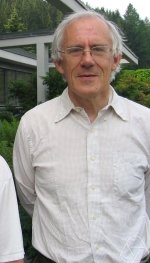
In mathematics, specifically group theory, given a prime number p, a p-group is a group in which the order of every element is a power of p. That is, for each element g of a p-group G, there exists a nonnegative integer n such that the product of pn copies of g, and not fewer, is equal to the identity element. The orders of different elements may be different powers of p.
In abstract algebra an inner automorphism is an automorphism of a group, ring, or algebra given by the conjugation action of a fixed element, called the conjugating element. They can be realized via simple operations from within the group itself, hence the adjective "inner". These inner automorphisms form a subgroup of the automorphism group, and the quotient of the automorphism group by this subgroup is defined as the outer automorphism group.

In group theory, the normal closure of a subset of a group is the smallest normal subgroup of containing
In mathematics, more specifically in group theory, a group is said to be perfect if it equals its own commutator subgroup, or equivalently, if the group has no non-trivial abelian quotients. In symbols, a perfect group is one such that G(1) = G, or equivalently one such that Gab = {1}.
In mathematics, computational group theory is the study of groups by means of computers. It is concerned with designing and analysing algorithms and data structures to compute information about groups. The subject has attracted interest because for many interesting groups (including most of the sporadic groups) it is impractical to perform calculations by hand.

1024 is the natural number following 1023 and preceding 1025.
Robert Arnott Wilson is a retired mathematician in London, England, who is best known for his work on classifying the maximal subgroups of finite simple groups and for the work in the Monster group. He is also an accomplished violin, viola and piano player, having played as the principal viola in the Sinfonia of Birmingham. Due to a damaged finger, he now principally plays the kora.
In mathematics, the coclass of a finite p-group of order pn is n − c, where c is the class.

Charles R. Leedham-Green is a retired professor of mathematics at Queen Mary, University of London, known for his work in group theory. He completed his DPhil at the University of Oxford.

Aner Shalev is a professor at the Einstein Institute of Mathematics at the Hebrew University of Jerusalem, and a writer.
In mathematical finite group theory, the L-balance theorem was proved by Gorenstein & Walter (1975). The letter L stands for the layer of a group, and "balance" refers to the property discussed below.
In mathematics, the concept of groupoid algebra generalizes the notion of group algebra.
In mathematics, specifically group theory, a descendant tree is a hierarchical structure that visualizes parent-descendant relations between isomorphism classes of finite groups of prime power order , for a fixed prime number and varying integer exponents . Such groups are briefly called finitep-groups. The vertices of a descendant tree are isomorphism classes of finite p-groups.

In computational group theory, a black box group is a group G whose elements are encoded by bit strings of length N, and group operations are performed by an oracle. These operations include:

Pham Huu Tiep is a Vietnamese American mathematician specializing in group theory and representation theory. He is currently a Joshua Barlaz Distinguished Professor of Mathematics at Rutgers University.
Bettina Eick is a German mathematician specializing in computational group theory. She is Professor of Mathematics at the Technische Universität (TU) Braunschweig.
Martin Liebeck is a professor of Pure Mathematics at Imperial College London whose research interests include group theory and algebraic combinatorics.
Wallace Smith Martindale III is an American mathematician, known for Martindale's Theorem (1969) and the Martindale ring of quotients introduced in the proof of the theorem. His 1969 paper generalizes Posner's theorem and a theorem of Amitsur and gives an independent, unified proof of the two theorems.









